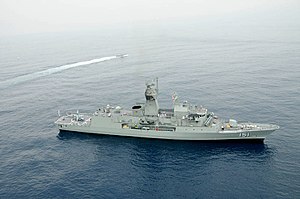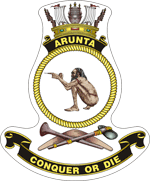HMAS Arunta (FFH 151)

HMAS Arunta in 2015
|
|
| History | |
|---|---|
|
|
|
| Namesake: | The Arrernte people |
| Builder: | Tenix Defence Systems |
| Laid down: | 22 July 1995 |
| Launched: | 28 June 1996 |
| Commissioned: | 12 December 1998 |
| Homeport: | Fleet Base West |
| Motto: | "Conquer Or Die" |
| Honours and awards: |
|
| Status: | Active as of 2016 |
| Badge: |  |
| General characteristics | |
| Class and type: | Anzac-class frigate |
| Displacement: | 3,810 tonnes full load |
| Length: | 118 m (387 ft) |
| Beam: | 15 m (49 ft) |
| Draught: | 4 m (13 ft) |
| Propulsion: |
|
| Speed: | 27 knots (50 km/h; 31 mph) |
| Range: | 6,000 nautical miles (11,000 km; 6,900 mi) at 18 knots (33 km/h; 21 mph) |
| Complement: | approximately 170 sailors |
| Sensors and processing systems: |
|
| Electronic warfare & decoys: |
|
| Armament: |
|
| Aircraft carried: | 1 × SH-60 Seahawk |
| Notes: | Post-Anti-Ship Missile Defence Project upgrade. See class article for original configuration. |
HMAS Arunta (FFH 151) is an Anzac-class frigate of the Royal Australian Navy (RAN). The ship, named for the Arrernte people, was laid down in 1995 and commissioned in 1998. Since entering service, Arunta has performed a wide range of duties, including border protection patrols in northern Australian waters, and several deployments to the Persian Gulf.
The Anzac class originated from RAN plans to replace the six River-class destroyer escorts with a mid-capability patrol frigate. The Australian shipbuilding industry was thought to be incapable of warship design, so the RAN decided to take a proven foreign design and modify it. Around the same time, the Royal New Zealand Navy (RNZN) was looking to replace four Leander-class frigates; a deterioration in New Zealand-United States relations, the need to improve alliances with nearby nations, and the commonalities between the RAN and RNZN ships' requirements led the two nations to begin collaborating on the acquisition in 1987. Tenders were requested by the Anzac Ship Project at the end of 1986, with 12 ship designs (including an airship) submitted. By August 1987, the tenders were narrowed down in October to Blohm + Voss's MEKO 200 design, the M class (later Karel Doorman class) offered by Royal Schelde, and a scaled-down Type 23 frigate proposed by Yarrow Shipbuilders. In 1989, the Australian government announced that Melbourne-based shipbuilder AMECON (which became Tenix Defense) would build the modified MEKO 200 design. The Australians ordered eight ships, while New Zealand ordered two, with an unexercised option for two more.
...
Wikipedia
